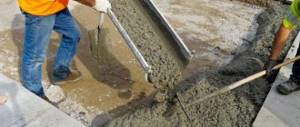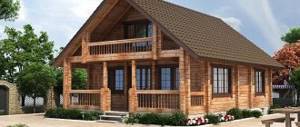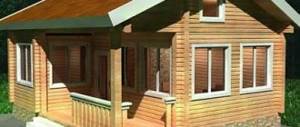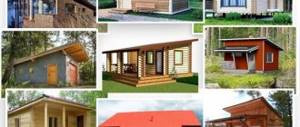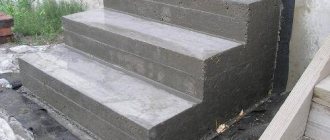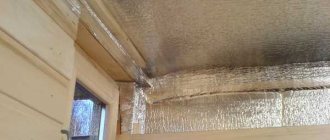A concrete pool is an expensive, labor-intensive and complex hydraulic structure. There are many designs of swimming pools, but if we talk about durability and reliability, a better concrete option has not yet been invented.
It can be assembled from individual elements or be a monolith; in any case, a multi-layer structure of external and internal waterproofing will be required. A concrete pool belongs to the classic type of reinforced concrete structures, but allows for countless modifications with the addition of bends, cascades, waterfalls, hydromassage and artificial flow.
The technology for constructing a concrete pool includes the mandatory implementation of the following steps:
- Project development.
- Preparing the base.
- Installation of embedded elements.
- Formwork installation.
- Reinforcement of the prepared pit.
- Stage-by-stage concreting.
- Waterproofing device.
- Finishing work and decoration of the surrounding area.
All stages of the technology for constructing a concrete pool are important; the correct execution of them will affect the final result of the work.
Before continuing reading, we would like to remind you that on our website you can order the construction of a swimming pool by creating a tender. Masters and companies will respond to your order and you will be able to choose the most suitable candidate.
Pool formwork
More and more homeowners are deciding to install a swimming pool on their property. The choice of pool options today is very large, for every taste and budget. You can purchase a plastic or fiberglass pool, or more precisely, a bowl made industrially from these materials, dig a pit and install it. As you can see, even with such an expensive option, excavation work cannot be avoided. The optimal solution would be to opt for a classic concrete pool.
Pool formwork
This article will talk about some of the intricacies of constructing small private ponds from concrete with your own hands, how to choose a location, prepare a pit, concrete, but most importantly, how to make formwork for a pool, this is one of the main points of construction.
Conclusion
Construction of concrete pools is not an easy and painstaking task. Each stage of construction does not like to be rushed and requires high responsibility. For the longevity of the pool, it is important to buy high-quality materials and think through all the little details and nuances in advance. Using the described pool construction technology, we obtain a high-quality and durable concrete pool. If a lot of things are unclear and difficult for you, then we recommend creating a tender on our website, where many craftsmen will compete for your order.
Stages of building a pool and some tips, subtleties and nuances
- Preparatory work - pool design, includes development of the structure and drainage system, determination of location, hydrostatic calculations.
- Excavation work, digging a pit.
- Bottom construction - adding a cushion, laying waterproofing material and reinforcing the bottom slab.
- Installation of formwork for a swimming pool.
- Concreting, placement of other elements.
- Plastering and finishing works.
- Leveling the bottom and walls, carrying out finishing work.
Of great importance is the creation of the pool bottom, drainage system and the correct composition of the concrete solution. The bottom of the pool has a complex multi-layer structure. You can buy concrete mortar or prepare it yourself. To fill the bowl, it is better to use special hydraulic concrete. Pouring concrete mortar is similar to monolithic construction techniques. If the project creates an oval pool, then it is recommended to buy reinforcement in coils (less than 10 millimeters in diameter). It can be cut into pieces of the required length.
Later in the article you will learn how to build:
- Pool made of polystyrene foam blocks.
- Pool made of sheet metal.
- Swimming pool made of concrete blocks.
Basic kit for designing and installing a swimming pool.
To build any pool you will need a standard construction and installation kit, which includes:
Set for construction and installation of a swimming pool.
- Materials for pool waterproofing;
- Facing film;
- Various fittings;
- Flange units;
- Skimmer;
- Filter (or several);
- Nozzles (underwater);
- Pump (specially designed for this purpose);
- Embedded parts;
- Stairs for convenient descent and ascent from the pool;
This is the composition of the construction and installation kit for building a swimming pool with your own hands. At will and decor, this list can be replenished, for example, with special devices for creating a flow in the pool (of course, artificially), a variety of lighting for the sides of the pool and lighting on the bottom. The list is also often replenished with special devices for protecting and cleaning the bottom of the pool.
Choosing the optimal formwork for a pool
Wood and plywood formwork
When creating formwork for a swimming pool, you can apply many solutions. It is traditional to create removable wooden formwork from boards and plywood. This is a difficult job that will take more than one day, but this technology allows you to make formwork of a complex curved shape, unlike ready-made panels.
Is there an alternative? You can use removable metal formwork - this is quite expensive, although the speed of work will increase several times.
However, today there is another promising technology - permanent formwork systems. When using them, the pool walls are assembled from hollow foam blocks. The work process is similar to assembling a LEGO set. As a result, we have a wall that does not require careful preparation before finishing.
Preference for permanent formwork made of polystyrene foam
- The final cost of the structure is lower by a third, or even half.
- Construction time is reduced significantly – by 50%. There is no shrinkage, finishing work can begin immediately.
- This building material is easy to transport; to bring the formwork, you will need one truck trip. During further installation work, the use of heavy equipment is not provided.
- Electricity is saved for heated pools, as polystyrene foam has excellent thermal insulation properties.
- The walls of the pool, cast in permanent formwork, are 25% thinner than those constructed using other technology.
- Less excavation work, since there is no need to excavate many cubic meters of soil around the perimeter
- The pool has ideal walls and corners that allow you to apply any finish, from a variety of materials, even from mirrors.
- This technology is suitable for the construction of all types of pools: skimmer, overflow, etc.
- An expanded polystyrene wall provides excellent cover for plumbing, drainage and electrical wiring.
Thus, the preference for permanent pool formwork made of foam blocks can be considered the optimal choice. The financial costs for such formwork are comparable to those for wooden formwork. After all, practice shows that most often purchased wooden consumables are only suitable for firewood or auxiliary needs. Sometimes they are simply thrown out, unless, of course, it is planned to build another pool of identical shape and geometry, which is unlikely.
What is a thermohouse? This building was constructed using permanent polystyrene foam formwork. It is enough to build a building using this technology with your own hands.
Monolithic construction using permanent formwork, despite its long history, has become widespread not so long ago. However, these .
Brick formwork for monolithic construction. For any person who has come into contact with construction, this combination of words sounds somewhat absurd. After all, it is monolithic.
Correct pouring of concrete into formwork is the basis for the quality and beauty of the future structure. Any business at the beginning requires a solid foundation -.
How to make formwork for a swimming pool
How to make formwork for a swimming pool? The formwork of the pool walls is made of boards, plywood, timber or corrugated sheets with the surface covered from the inside with film. This design does not require special skills or complex equipment. Even a beginner in this matter can cope with such a task.
The formwork for a pool is its most important part, on which the correct shape and durability of the bowl largely depends. The result of all work depends on the quality of the formwork; this determines the choice of formwork.
Do-it-yourself pool lining at home
Before starting the lining, install an additional layer of waterproofing. At the same time, each crack is sealed so that liquid does not penetrate into it. For this purpose, various impregnations, mastic or polyethylene are used.
Then they move on to finishing work. Ceramic tiles are used for these purposes. The material is moisture resistant and easy to care for.
An alternative to ceramics is plastic film.
The choice of lining materials for the pool is quite wide. You can choose not only a practical lining, but also one to suit any design. It is also necessary to take care of additional equipment for the reservoir.
Additional equipment for the pool:
- Filtration. Such equipment makes the water cleaner. This makes pool maintenance much easier.
- Heating. Allows you to heat the water to a comfortable temperature and swim even in cold weather.
- Lighting. Lighting is a fairly practical solution. This way you can use the pond in the evening.
The area around the pool will also have to be specially developed. The surrounding area is tiled. It is important that it has an anti-slip coating. You can also arrange a border made of decorative stone.
Types of formwork
Pool formwork can be of two types:
- Removable.
- Fixed.
Removable formwork is made of beams and laminated plywood. This formwork is made at a small height, which is just enough for the walls of the pool. The bars are driven in around the perimeter of the pool giving the required shape. Wooden boards, plywood or any available material are nailed to the beams. The main thing is that there is no leakage of the concrete mass. You can lay film on the inside. The wood can be any kind, it will still be removed after the cement dries. Using plywood, it is very convenient to erect the formwork of a round pool. It bends well and takes the required shape.
Installing removable formwork is a complex job that will take more than one day, but this technology allows you to make formwork of a complex curved shape, unlike ready-made panels.
Permanent formwork is made of reinforcement, metal or polystyrene boards. The latter, in combination with reinforcement, create a very strong concrete bowl. In addition, polystyrene boards are not only a convenient material for work, but also good thermal insulation and additional protection of concrete walls from moisture. But before you start constructing the formwork, you need to do a number of mandatory works:
- Decide on a location for the future pool.
- Dig a pit.
- Make a bulk pillow.
- Proceed with the construction of the pool bottom formwork.
- Erect formwork for the pool walls.
ADVICE!
Permanent formwork will significantly reduce the time needed to build a pool and save some materials. This occurs due to the fact that the formwork does not need to be removed and it already has waterproofing functions.
Filling the bottom with concrete
Self-prepared concrete will cost less, but then you need to have several assistants for the work, so that one person prepares the concrete, another pours the solution, and a third levels it. Formwork for the bottom of the pool will help to carry out the pouring process more smoothly and accurately. To prepare concrete you will need:
- concrete mixer;
- vibration installation;
- cement M500;
- sand;
- water-repellent additives;
- water.
The quality of concrete greatly depends on the purity of its components. To preserve all the properties of the substance, we buy bags of cement no earlier than a month before pouring. We use crushed stone of a fraction from 10 to 20 mm; it should not contain foreign impurities. The preferred sand granule size should be up to 2mm. On average, a bucket of M500 cement will require 5 buckets of sand and 7 buckets of crushed stone. For good mixing of materials, it is better to use a concrete mixer. To get a high-quality solution, add the components in the following order:
- Mix sand and cement.
- Add water and stir until it reaches the consistency of sour cream.
- Add crushed stone.
- Before pouring, add a hydraulic additive to the solution.
Fill the solution with a slight slope towards draining the water. The minimum thickness of the pool bottom is 15 cm. The larger its size, the thicker the bowl is needed. During the pouring process, you should focus on the maximum density of concrete and the absence of air voids in its thickness. For this we use a vibration machine. The reinforcement must be inside the concrete solution. Leave the filled bottom to dry completely for 10-12 days.
Choosing a location for a pit
If you don’t need a “pig in a poke,” then before starting excavation work, be sure to contact the geodesy service. They will conduct the necessary research, and you will not go wrong with choosing a location for your future pool. Since the nearby groundwater either did not allow filling, or would eventually destroy the concrete bowl of the pool. It is advisable to exclude the presence of green spaces near the pool, as they will be an additional source of garbage. But close proximity to sources of light and water is very necessary. For future connection to communications.
Plastering
To ensure reliable adhesion of the plaster to the concrete, before plastering the walls we prepare them:
- Manually make the surface of the bowl more rough.
- Using dowels, we attach the mesh to the pool bowl.
- Before fixing, we treat the mesh with a special anti-corrosion agent.
After fixing the mesh, apply moisture-resistant plaster to it, level the pool bowl as much as possible and leave it to dry completely. After drying, we install the embedded parts of the pool.
Digging a pit
The first step is to decide on the size and shape of the future pool. If you are building it yourself, it is better to go with a rectangular or oval shape. In addition, the simpler the shape of the pool, the less costs will be spent on equipment. Since intricate shapes require more filtering equipment. Markings can be made using pegs and a stretched rope between them. The top layer of soil and subsequent layers are removed along the intended perimeter. This method is considered the most convenient. The walls are torn out along the outer slope to prevent soil shedding. The desired depth for the pool is 1.5 m, length about 5 m. The hole is dug 60 cm deeper and wider on all sides; this reserve is needed for a cushion under the bottom and a concrete base.
In addition to the pit for the bowl, a recess for the drainage system and equipment is necessary. It is certainly smaller in size than the main bowl, but deeper.
ADVICE!
Follow the rule that the bottom plate is larger in area than the bottom of the pool bowl. If the bottom slab is located at a level above which groundwater rises, then drainage must be performed along its perimeter.
Where to place a DIY pool in the yard
Purchased options can be placed at your discretion, since this is still a building for the season. But a permanent pool must be installed according to certain rules. Basically, many rely on personal preferences, but one should not neglect the recommendations that will help install the structure correctly.
Factors influencing pool placement:
- Soil properties. Clay soils, which provide natural waterproofing, are considered ideal. In addition, when building a pool, you need to take care of the foundation pit. If the ground is rocky, this process will be difficult.
- Direction of the wind. An outdoor pool will be an excellent place to collect any debris that is blown into the pond by the wind. In order to protect the building, the prevailing windy part is determined and isolated.
- Presence of vegetation next to the pool. If there are trees or bushes nearby, the roots can easily damage the frame.
Determining the size of the pool depends entirely on personal wishes. It is important to understand what kind of reservoir the owner can afford, based on the scale of the site. You need to sensibly assess your strengths.
For swimming along one path, a reservoir width of 2.5 m and a length of 5 m is enough. Two paths add width up to 4 m.
The normal depth of the pool is 1.4 m. But this figure may vary depending on the purpose of the construction. For children, the pond is made shallow. And for those who like to dive, the depth is increased.
However, it is not recommended to install the pool on a wooden platform. Also, for the reliability of the structure, the foundation must be sufficiently strong and completed. There is no need to equip the structure in a zone of seismic activity, on creeping and loose soils.
Preparing a bulk cushion for the base of the pool
An insulating material in the form of a film or roofing felt is placed at the bottom of the finished pit. The second one is stronger in quality and will not tear during further work. The sheets are laid overlapping each other in two layers. Firstly, it is additional thermal insulation for the pool and protection from the impact of soil on concrete. Secondly, it will prevent the soil and bulk material from mixing. Crushed stone is poured on top and compacted. The second layer is compacted sand. Starting from the pillow, a slight slope is formed towards the drainage hole.
backfilling
Backfilling is carried out manually and evenly so that the bowl does not move or tilt. We install insulation sheets at a distance of 25 cm from the outer edge of the pool. We fill the space between it and the bowl with a mixture of sand and cement (for 1 bucket of cement we use 3 buckets of sand). We slightly moisten the cement-sand mixture with water. We fill the distance between the insulation and the foundation pit with sand, this will improve the tightness and density of the backfill. Backfilling is carried out in several stages over 3-5 days for better sand shrinkage.
Formwork for the base of the bottom of the future pool
After preparing the cushion, formwork is needed for the foundation of the pool at the bottom. A concrete bowl reinforced with reinforcement will last longer, so you need to start with laying the reinforcement:
- Along the perimeter of the pit, rods are vertically inserted into the soil; firstly, they create the outline of the pool, and secondly, they serve as additional strength for future walls.
- Vertical reinforcement is fastened together with horizontal rods, which are fixed with strong wire. For reinforcement, metal corrugated rods with a diameter of 10-20 mm are used.
- The width of the slab should be 20 cm. Accordingly, the reinforcement in the concrete should be 10 cm apart from each other. This distance is created using brick halves, on which metal rods are laid. The bricks are laid along the entire perimeter of the bottom with a distance of 20 cm from each other. Visually, the picture should resemble a grid on the bottom and walls. The rods are secured with wire.
- The bottom structure is filled with moisture-resistant concrete.
IMPORTANT!
When constructing a frame, it is very important not to use welding in those places where the reinforcement intersects and is tied together. Because the welding process can disrupt the structure of the metal, burning off carbon, and this is the first reason for the appearance of “rust”. It is best to use steel wire with a diameter of up to 3 mm. or plastic clips.
Formwork for pool bowl walls
After the concrete base has dried, construction of the formwork for the pool bowl begins. Roofing material is laid on the soil, as well as on the bottom. For external protection of future concrete walls. To do this, formwork is constructed from beams and durable waterproof chipboard or plywood. In addition, in the center of the wooden formwork you should have the reinforcement that you erected while pouring the bottom. Support beams are installed between the walls. They will prevent the structure from collapsing, since concrete creates strong pressure. If the installation of the pool formwork is ready, then cement-sand mortar is poured into it. To prevent voids from forming in the cement, it is necessary to pierce it with a piece of reinforcement and perform mixing movements. This will allow the solution to better fill the mold.
ADVICE!
The structure dries for about a month, and in extreme heat it is watered to prevent cracking of the concrete.
Another wonderful material for constructing formwork is polystyrene boards. It is easier and more convenient to work with them. They are light in weight and take the required shape. They are placed parallel to each other, creating a void. Otherwise, the operating technology is the same as described above.
Advantages and disadvantages as a base for a frame
The following advantages are highlighted:
- No dents under heavy load from water or human feet.
- The soft but durable structure is preserved, there is no rotting, swelling, or change in shape.
Maintaining warm water in the pool, preventing the temperature from decreasing overnight.- There is no risk of fungal growth or bacterial infection, because the material does not allow biologically active structures to pass through.
- Protects the base of the pool from rodents; they do not gnaw on it and do not choose it for nesting.
- No harmful effects on the human body (no mutagenicity, carcinogenicity, or reproductive toxicity from the contained substances has been detected).
- The price is lower than other materials (wood, gravel) that could become the basis for a pool.
There are a small number of negative qualities:
- Easy flammability from lit matches, blowtorch, welding.
- Destruction due to accidental contact with solvent.
If we compare the positive and negative aspects, it becomes clear that polystyrene foam is the best base for a pool.
Formwork for the pool base
The pool has a horizontal base and vertical walls. The use of volumetric formwork, which allows simultaneously casting both the bottom and the walls during independent construction, is hardly possible, so the work has to be carried out separately. Before making the formwork for the pool, you need to prepare the foundation pit:
- prepare the site;
- make markings using pegs and ropes;
Advice! When building a pool yourself, it is best to make it rectangular or oval. More complex configurations will require additional costs, including the cost of water filter systems.
- According to the markings, the top layer of soil is removed; further excavation of the pit is recommended to be done in layers;
- the size of the pit depends on the desired size and depth of the pool, and it is necessary to increase all indicators (length, width, depth) by 0.6 meters. This is necessary to make a special substrate that will protect the structure from seasonal soil movements;
- The bottom of the pit is well compacted, then roofing material or dense polyethylene is laid on it, extending onto the walls. Tapes of waterproofing material are laid with an overlap;
- Next, we pour a layer of crushed stone, which compacts well, after which a layer of sand is poured, which also needs to be compacted. Already at the stage of forming the “substrate” it is necessary to form a slope towards the drainage hole;
- Then you can start performing reinforcement. Metal rods are installed around the perimeter. Vertical elements are connected to horizontal ones, the elements are fastened using wire;
- horizontal rods at the bottom of the future bowl cannot be laid on the ground, they must be in the thickness of the concrete, so they are lifted by laying them on halves of bricks;
- bricks are laid all over the bottom at a distance of 20 cm from each other;
- correctly assembled reinforcement resembles a mesh with a cell width of 20 cm;
- Having finished assembling the reinforcement, pour it; the thickness of the slab should be at least 0.2 meters.
Construction technology
Digging a pit and pillow
After marking the selected area, you need to dig a pit for an artificial reservoir.
If you are planning an outdoor pool made of foam concrete, you first need to make markings for the future foundation pit. To do this, pegs are installed around the perimeter, taking into account the planned dimensions, and string is stretched. Next, a ditch of a given depth is dug. It is important to compact the bottom of the hole thoroughly and additionally create a slope that will serve as a drain. Then a drainage cushion of 30 and 10 cm, respectively, is formed from sand and gravel above the ground. At this stage, the mortgages for the drainage system are installed.
Pouring the foundation and composition of the mortar mixture
After constructing the pit, the filling solution is mixed; its composition is cement, sand and crushed stone. Proportions - 1:5:8. To make the structure reliable, the following types of concrete additives are used to make it waterproof:
- polymer;
- plasticizing;
- clogging.
The next stage of work is the first layer of floor screed for the structure.
Next, concreting is carried out, and when the screed has set, you should cover the bottom with a waterproofing material made of roofing felt, immediately soldering the joints using a construction hair dryer. Then the embedded drain pipes are installed; the recommended material is PVC; there should be drainage wells at the bends of the pipe.
Reinforcement
The protective layer of concrete for the reinforcement is poured carefully so that the waterproofing substrate is not damaged. It is recommended to concrete using a 2-layer reinforcing mesh placed at the bottom of the ditch and along the wall, while simultaneously deepening the rods into the mesh system. The ground layer should be secured with 3 layers of mesh.
Pouring the walls of the bowl
The walls must be poured after checking that the formwork has been installed correctly.
The thickness of the walls of the pool depends on its volume. For a structure measuring 4x4 m and 150 cm deep, the wall should be no thinner than 10-15 cm. It is important to strictly maintain the vertical of the formwork, and also to further strengthen it so that the pouring pressure does not destroy the frame. An alternative to wooden formwork can be a reinforcing wall made of thermoblocks, aerated concrete or concrete blocks. At the final stage, the pool is insulated and filled with concrete.
Finishing and insulation
Before starting finishing work, you should wait until the concrete pool is completely dry. After complete hardening, waterproofing and cladding begin. The surface of the wall must be finished with a special water-repellent solution, the preparation method and proportion of which are indicated in the instructions. Then you need to leave the impregnation to dry. To check the reliability of waterproofing, you should fill the concrete pool with water for a week. Over the next days, monitor the water level. If it decreases, you need to find the damaged area and repair the defect.
The inside of the structure can be covered with PVC film.
When the main construction stages are completed, they begin finishing the inner bowl of the pool. The surface can be plastered and painted with a special water-repellent paint or decorated with decorative tiles, mosaics, or PVC film. It is recommended to lay a special tile around the perimeter of the bowl, on which wet feet will not slip; a jumping board or ordinary steps are installed in front. The composition and characteristics of the water in the pool should be as close as possible to drinking water, therefore the bathtub is additionally equipped with a cleaning system.
Formwork for the pool bowl
You can begin assembling the formwork for the walls of the bowl after the bottom has hardened. The size and shape of the bowl depends on the project, but the easiest way is to assemble rectangular formwork with clear corners. For construction, it is convenient to use ready-made block forms or moisture-resistant plywood.
Plywood is easier to shape into the desired shape than boards. When using these materials, the surfaces of the concrete bowl will be smooth, so finishing will be easy. The shields are installed at a distance from the pit slope, and this distance should be equal to the thickness of the wall being cast.
Installation and dismantling of structures
When performing installation work, you need to know, first of all, that the forms must be airtight, this will prevent leakage of the concrete mixture. For this reason, it is better to use ready-made foam blocks.
They are easy to install; special holes are provided in them to remove the reinforcement. An important advantage is that the blocks will not need to be dismantled. Finishing is carried out directly on the foam using a plaster mesh.
So, building a pool on a site is a difficult, but completely solvable task. To cast a concrete bowl you will need formwork. It is best to assemble it from ready-made block forms; this will significantly reduce the labor intensity of the work. But you can build the formwork for casting the walls of the bowl yourself, using plywood and boards.
Alternative option
If you don’t have the funds and space on your property for a large pool, you can make a cute bathhouse near the bathhouse or a decorative pond from concrete rings with your own hands. And for this you will need one standard reinforced concrete ring and a lifting mechanism capable of lowering it into the pit.
Everything else is based on the technology of constructing a concrete pool. True, it will not have a filtration system, but with such a volume of water you can get by with chemicals. But such a tiny pool is easy to operate and repair and regularly solves its functional problems.
Construction of a swimming pool from permanent formwork
New technologies in swimming pool construction
There are several options for installing a turnkey pool on your property. Some people prefer to install an inflatable one. The advantage of this choice is efficiency, because water procedures in such a pool can be taken within a few days. But there is also a significant drawback to the inflatable tank - its short service life. A more serious option is to install a polypropylene bowl. Such a tank is put into operation in three to four weeks, but not everyone can afford this expensive option. Today, a concrete pool does not suit everyone. Therefore, now many people choose the best option - a pool made of foam blocks. Its installation will take some time, but the budget is acceptable for many. In addition, this water container has proven itself well in practical terms.
Expanded polystyrene blocks are an excellent building material for swimming pools
Today, the construction industry presents a large number of inexpensive materials that are used to make swimming pools. Against their background, large-sized blocks made of foam plastic and those inferior in size - made of concrete - are especially distinguished by their price-quality ratio.
Practice shows that the technology of using blocks in the construction of large and small water tanks is today one of the most promising.
Permanent formwork using blocks was first used by the French a quarter of a century ago. A successful constructive solution gradually found recognition in many countries around the world, and Russia was no exception.
Preparatory stage
Create your own estimate for the construction of a country pool. Before calculations you need to determine:
- Pool size. Based on the budget and the number of people who will swim in it.
- Depth and its shape. If you have no experience in construction, it is better to choose a regular rectangular shape. Convenient bowl depth – from 1.5 meters.
- The thickness of the structure. The deeper the pool, the more reliable its base should be; the thickness should not be less than 15 cm.
- Geology of the site. It is better to order a geodetic study of the land plot, which will determine the density of the soil and groundwater level, and will help you choose the best place for installation.
- Pool equipment. Proper selection of equipment and embedded elements will allow you to use the pool comfortably and reliably.
- The proximity of the pool to other buildings. Neighboring foundations will put a load on the foundation pit, so all buildings must be completely autonomous.
- Materials. Construction must be carried out with high-quality and proven materials.
The preparatory stage in the construction of a concrete pool is very important; the accuracy of subsequent processes and the overall result of the work depend on it.
